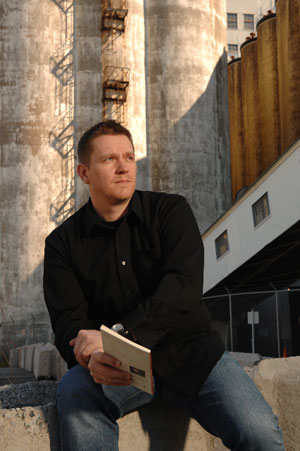 |
| Matt Robinson by the grain elevators on the Halifax waterfront: "industry's crumbling veneer." (Danny Abriel Photo) |
Ruminations of Matt Robinson’s imagination are plotted on for everyone to see.
Those dozen or so pinpoints actually indicate Halifax landmarks like the Dingle Tower and the Angus L. MacDonald Bridge. But on this map, the places are meant to be viewed the way the poet sees and writes about them in his latest collection of poetry, Against the Hard Angle.
Fredericton was Mr. Robinson’s home for 10 years, and since moving back to Halifax where he works as Residence Life Manager at Dalhousie’s Howe Hall, he’s viewing things in a new light. “This is about re-establishment with or rekindling of a relationship with place as opposed to a person,” he explains about “Toeing the Slack-Roped Narrows,” the name of his book’s second section. “I did try to actively pick places that would be interesting in some ways to people so that would have some familiarity. And then other places are far more personal.”
“Historic Properties & the Like” is perhaps the most personal poem of the section. Mr. Robinson writes about drinking beer and looking out at a wall, marked by the silhouette of a demolished building. He’s coming to terms with a loss and understanding someone is not going to return. “So you throw that worn fact down your throat / and work your neck,” he writes.
Tension ripples throughout the collection. And it’s why he’s drawn to the places he writes about. “There’s a tension between the Public Gardens, the seaport and the grain elevators,” he says, describing the grain elevators as a bulk. “There’s harshness to it… There’s a stripped-down nature to that kind of architecture. It’s a weird combination of being nothing but function, but at the same time being the most dominating form you can have.”
 |
| Track the "poetic snapshots"¬Ýfrom Matt Robinson's book, Against the Hard Angle. |
The grain elevators become another symbol of lost love for the poet, who describes them as¬Ý ‚Äú‚Ķstress-fractured and cracked like this dun-dull brute tonnage.‚Äù However, Mr. Robinson admits some people actually gravitate to the bleak, industrial nature of the grain elevators. He jokes this would be especially true if the structure was turned into lofts.
Another Halifax signpost featured in the book is Citadel Hill.
He refers to it as the elephant in the room. “It really became evident that there was a giant mass that is really almost incongruous… this massive heft of stone and soil,” he says. In his poem, he turns the national historic site into a character, a “…hulking, hillocky / older kid” who hawks-up and loudly spits once a day like clockwork.
Gazing upon the Google map created by the poet’s publisher, one can imagine poeteering – a combination of poetry and orienteering – or, walking through the city and visiting each poem’s location. “Because that part of the book is so regionally-grounded and (Halifax is) not necessarily a place that everyone has been, we wanted to draw attention to those specific places,” says Jennifer Knoch, associate editor with ECW Press in Toronto. “The idea is someone with a smart phone could bring up the map standing in that place, read (the specific poem) and see it through Matt’s eyes.”
This is a marketing strategy that embraces today’s popular technology. As Ms. Knoch explains, it is a way for her client to attract new readers, potentially by accident. If someone happens to search for maps of Halifax online, there is a chance they will click on Mr. Robinson’s poeteering map and maybe end up buying his book.
A handheld electronic walking tour of his Halifax landmarks makes perfect sense to Mr. Robinson. After three weeks of activity, the online map has had over 2,600 hits. Visit mattrobinsonpoet.wordpress.com and use the Google map to begin poeteering, Matt Robinson-style.
LINKS: |
